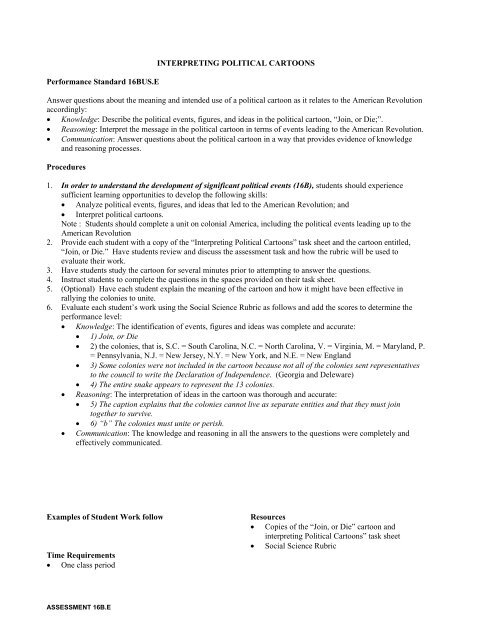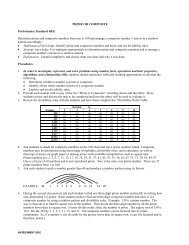16B.E - Interpreting Political Cartoons
16B.E - Interpreting Political Cartoons
16B.E - Interpreting Political Cartoons
You also want an ePaper? Increase the reach of your titles
YUMPU automatically turns print PDFs into web optimized ePapers that Google loves.
Performance Standard <strong>16B</strong>US.E<br />
INTERPRETING POLITICAL CARTOONS<br />
Answer questions about the meaning and intended use of a political cartoon as it relates to the American Revolution<br />
accordingly:<br />
• Knowledge: Describe the political events, figures, and ideas in the political cartoon, “Join, or Die;”.<br />
• Reasoning: Interpret the message in the political cartoon in terms of events leading to the American Revolution.<br />
• Communication: Answer questions about the political cartoon in a way that provides evidence of knowledge<br />
and reasoning processes.<br />
Procedures<br />
1. In order to understand the development of significant political events (<strong>16B</strong>), students should experience<br />
sufficient learning opportunities to develop the following skills:<br />
• Analyze political events, figures, and ideas that led to the American Revolution; and<br />
• Interpret political cartoons.<br />
Note : Students should complete a unit on colonial America, including the political events leading up to the<br />
American Revolution<br />
2. Provide each student with a copy of the “<strong>Interpreting</strong> <strong>Political</strong> <strong>Cartoons</strong>” task sheet and the cartoon entitled,<br />
“Join, or Die.” Have students review and discuss the assessment task and how the rubric will be used to<br />
evaluate their work.<br />
3. Have students study the cartoon for several minutes prior to attempting to answer the questions.<br />
4. Instruct students to complete the questions in the spaces provided on their task sheet.<br />
5. (Optional) Have each student explain the meaning of the cartoon and how it might have been effective in<br />
rallying the colonies to unite.<br />
6. Evaluate each student’s work using the Social Science Rubric as follows and add the scores to determine the<br />
performance level:<br />
• Knowledge: The identification of events, figures and ideas was complete and accurate:<br />
• 1) Join, or Die<br />
• 2) the colonies, that is, S.C. = South Carolina, N.C. = North Carolina, V. = Virginia, M. = Maryland, P.<br />
= Pennsylvania, N.J. = New Jersey, N.Y. = New York, and N.E. = New England<br />
• 3) Some colonies were not included in the cartoon because not all of the colonies sent representatives<br />
to the council to write the Declaration of Independence. (Georgia and Deleware)<br />
• 4) The entire snake appears to represent the 13 colonies.<br />
• Reasoning: The interpretation of ideas in the cartoon was thorough and accurate:<br />
• 5) The caption explains that the colonies cannot live as separate entities and that they must join<br />
together to survive.<br />
• 6) “b” The colonies must unite or perish.<br />
• Communication: The knowledge and reasoning in all the answers to the questions were completely and<br />
effectively communicated.<br />
Examples of Student Work follow<br />
Time Requirements<br />
• One class period<br />
Resources<br />
• Copies of the “Join, or Die” cartoon and<br />
interpreting <strong>Political</strong> <strong>Cartoons</strong>” task sheet<br />
• Social Science Rubric<br />
ASSESSMENT <strong>16B</strong>.E
Name ____________________________________________________ Date ______________<br />
INTERPRETING POLITICAL CARTOONS<br />
In the spring of 1754, England and France were on the verge of war, and America was to<br />
be the battleground for this conflict. England’s chain of thirteen colonies skirted the Atlantic<br />
Coast while France claimed the territory along the St. Lawrence River valley and across the<br />
Appalachians. As English settlers began moving west, they were being attacked by the French<br />
and their Native American allies.<br />
To cement an alliance with the Iroquois Indians, seven English colonies sent delegates to<br />
a meeting in June that year in Albany, New York. Ben Franklin, one of the delegates from<br />
Pennsylvania, also had a proposal in mind. He suggested a plan that “one general government<br />
may be formed in America including all of the said colonies.” Although the group adopted<br />
Franklin’s Albany Plan of Union, the plan was never carried out.<br />
Hoping that people would support the plan, Franklin published the cartoon, “Join or Die.”<br />
It was one of the earliest political cartoons produced by an American. A political cartoon uses<br />
pictures, symbols, and words to make a statement about current political issues or events.<br />
Respond to and complete the following questions:<br />
1) State the title or caption of the cartoon.<br />
2) What does each of the segments represent?<br />
a) S.C.<br />
b) N.C.<br />
c) V.<br />
d) M.<br />
e) P.<br />
f) N.J.<br />
g) N.Y.<br />
h) N.E.<br />
ASSESSMENT <strong>16B</strong>.E
3) List the colonies that are not included in the cartoon.<br />
4) What does the entire snake appear to represent in the cartoon?<br />
5) What does this caption explain about the drawing of the snake? In other words, what meaning<br />
do you get from the entire cartoon – both drawing and caption?<br />
6) Which statement best describes the message of the cartoon?<br />
a) Never cut up a snake.<br />
b) The colonies must unite or perish.<br />
c) If a snake grows back together, the colonies will be strong.<br />
ASSESSMENT <strong>16B</strong>.E
ASSESSMENT <strong>16B</strong>.E

















